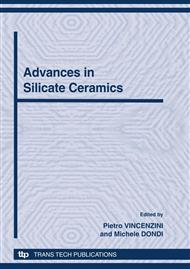p.65
p.75
p.84
p.90
p.96
p.102
p.108
p.114
p.120
Visible and Infra-Red Reflectance of Several Typical Japanese Glazes for Roof Tiles and Wall Tiles
Abstract:
. Tile coating with a higher reflectance of sun light are effective in mitigating heat-island phenomenon. Covering the surface of the ground or the exterior of buildings with such high reflectance coatings has attracted attention because of its high cost effectiveness. Recently, companies producing Japanese roofing tiles or wall tiles have been trying to develop high reflectance glaze for their products. However, while we have enormous amounts of data on visible reflectance measured through the study of glaze coloration, there are comparatively less data pertaining to infrared reflectance on pottery glazes. Though optical properties of simple glass and ceramics have been extensively studied, pottery glazes are complex glass-crystalline micro-composites. The pottery glazes sometimes have heterogeneous structures caused by phase separation, crystallization in the base glass, oriented crystallization on the surface, and so on, which are considered to affect infrared reflection. In this paper, several kinds of typical Japanese glazes are characterized from the point of view of the visible and infra-red spectral reflectance, and the improvement of these characteristics is discussed.
Info:
Periodical:
Pages:
96-101
Citation:
Online since:
October 2010
Authors:
Keywords:
Price:
Сopyright:
© 2010 Trans Tech Publications Ltd. All Rights Reserved
Share:
Citation:


